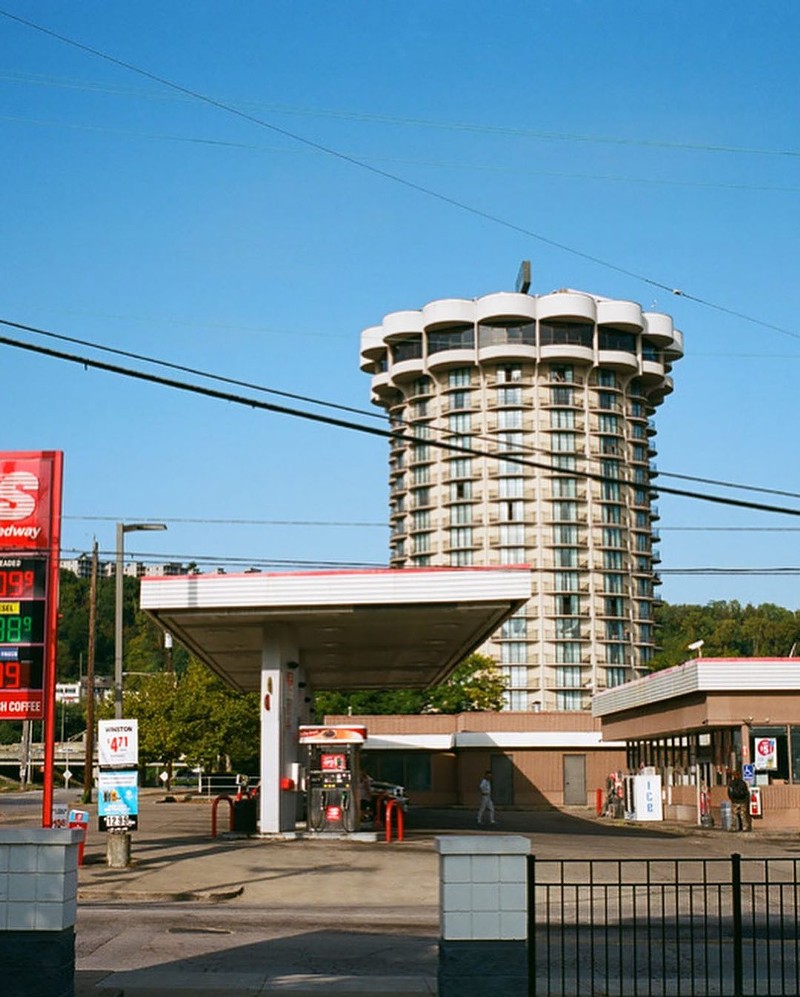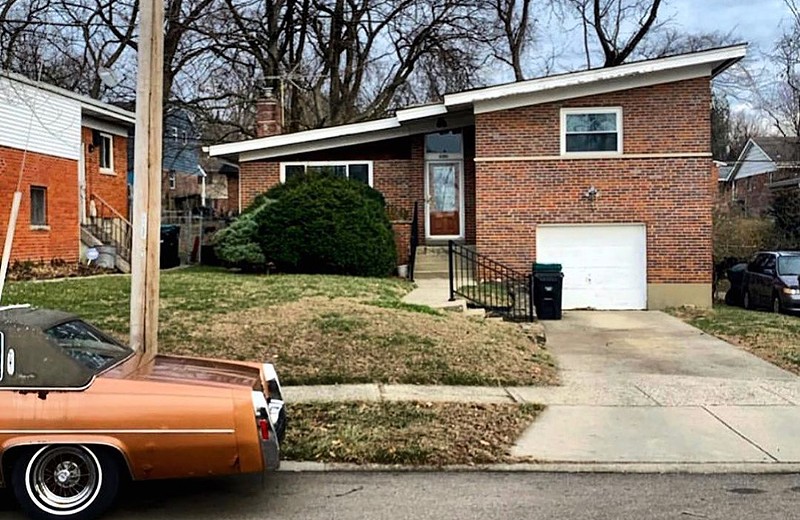
It was just over 50 years ago that the Cincinnati Reds logged their final game at the now-destroyed Crosley Field, but its spirit still lingers on in the lot behind City Gospel Mission in the West End, where the field was once located.
A memorial with replica light towers and yellow foul poles juts from the pavement like ancient ruins. A mural of Crosley Field — and an informational plaque — lets passersby get a glimpse into the park’s past. Once a green oasis, the site is now occupied by warehouses and storage units.
In the building across from the mural is the studio of Jerald Cooper, a self-defined creative director who is best known for running the popular Instagram account Hood Century (@HoodMidCenturyModern). Hood Century is dedicated to revealing the architectural history and importance behind otherwise-unassuming locations — like the Crosley lot, along with libraries, dry cleaners, apartment complexes, abandoned buildings and more — in Cincinnati, Los Angeles, Mexico, Paris and beyond.
Billed as the “streets’ preservation society” in its bio, with the tagline “Yes!! There is mid-century modern design in the hood!,” Cooper launched the instagram account in late 2019. What started with him wanting to show his friends the architecture of his hometown, Cincinnati, became a community of more than 50,000 followers, garnering national recognition in outlets such as Vogue, Dwell and Architectural Digest.
The attention also has landed Cooper some high-profile collaborations: an editorial in Elle; a week-long residency at Neutra VDL Studio, an architecture museum in California; and work scouting locations for music videos (Before starting Hood Century, Cooper managed musicians like British R&B singer Ama Lou and Young Guru, best known as Jay-Z’s producer).
Today, Hood Century functions as more than just a slideshow — it’s an art gallery, blog, educational tool and cultural archive all rolled into a single vertical scroll.
Between photo carousels showcasing the work of John S. Chase, Texas’ first licensed Black architect, or a boxy home built in L.A. 's View Park-Windsor Hills neighborhood, you’ll find dispatches from Cooper’s travels and personal life, sometimes paired with just a single word or emoji.
In a post from September, Cooper points to the exterior of an unusual preschool that vaguely recalls the flat lines of Frank Lloyd Wright’s Prairie style. “Cute, might delete later,” reads its tongue-in-cheek caption. In another, he documents a meal at Pann’s Restaurant, a retro diner that has been featured in episodes of Insecure and Bewitched.
Cooper first developed an interest in architecture through traveling, exploring cities and noticing the “art that just happens to be buildings.” That led him to researching the built environments he found himself in. Stacked throughout his studio are books on architecture, art and urban design; linked on his Instagram profile are videos, articles and PDFs on varying topics. Knowing the language of architecture and making it accessible to his follower base is at the heart of Hood Century’s mission.
“One of my big things is what Black people don't know,” Cooper says. “I don't like it because it basically keeps us out of things. If you don’t know wine, it is hard to really schmooze with the CMO or CEO. I always remember being like, ‘Man, we need to know this.’ Everybody's talking about gentrification and nobody knows their neighborhood.
“Nobody knew the architecture and knew the history of the people (that came) before. Nobody knows what's coming into the neighborhood, who’s building in the neighborhood. Nobody knew a lot of the things that are now on the account.”
It’s become increasingly clear that Hood Century isn’t just an architectural descriptor. It’s a way of life.
Hood Century Is for the Kids
It’s just cold enough for a few errant snowflakes to fall when Cooper descends the stairs leading to his studio. There’s a sticker depicting Solange Knowles sitting on the roof of the Guggenheim, photoshopped pale pink, affixed to his mailbox. He suggests we grab breakfast, and we hop in his truck in search of somewhere to get food.
“I was up until, like, 6:30 this morning watching the English Premier League,” he says, turning on the heat and Half God, the latest album by New York City rapper Wiki.
“It’s funny that I’ve been living between Los Angeles, New York and London for the last eight years. People will ask, ‘Why would you live in London?’ It’s literally just like this,” Cooper says, referring to the dreary weather. “I just didn’t have an explanation. Man, you get called places for shit other than weather.”
After some deliberation, we land at Otto’s in MainStrasse for brunch. There, he reflects on a Hood Century post from early November — a video of a young girl in yellow rain boots balancing atop an oddly-shaped park bench. Her mother had sent Cooper the clip.
“Is this Streamline or Art Deco?” she says, giggling, before leaping from its backrest. She’s leaning toward Art Deco, but the girl’s brother seems to think its curved lines suggest the former’s influence.
“Be honest,” reads Cooper’s caption. “You ever heard a kid of color asking a question like this?”
“That makes me want to cry,” he says, noting that he sent the family a pack of his Hood Century Flashcards after seeing it.
Bound with cardboard and rubber bands, the 5-inch-by-7-inch informational cards offer quick lessons in architectural design and were made to complement the Hood Century account (they were previously available for sale online). On each, there are handwritten, bulleted descriptions of building styles from Metabolism, a Japanese movement modeled after living cells, to Brutalism, which was coined for its heavy use of concrete. A sketch by Joe Walsh, a graduate of the University of Cincinnati’s College of Design, Architecture, Art and Planning (DAAP), appears on the flipside of each, illustrating each concept with charming simplicity. Covington’s Radisson Hotel is featured on the Midcentury Modern card — a building that is one of Cooper’s favorite photographic subjects.
“That’s a kid who’s going to feel like, at a young age, that they can and should know that there are styles of buildings. I grew up not even knowing there were different styles,” he says. “You know, it was old or new. That means a lot to me and it’s what I really want this account to do.”
In 2022, Cooper is planning to develop the Hood Century brand outside of the Instagram account by adding a website stocked with learning tools and merchandise, such as T-shirts and socks printed with buildings featured in past posts. Cooper also hopes to expand Hood Century’s social media presence to reach a younger audience of digital natives whose online lives center around games.
“The gamification of education is a huge thing,” Cooper says. “(The hope is) to start this thing at the West End library using Roblox and Minecraft. What if we used those tools to help a kid think about architecture and urban development?”
Many of Cooper’s innovative ideas about education stem from his upbringing in Montessori schools, which stressed meditation, collaboration and testing unique approaches to learning. Much of that same ethos translates to discussions that take place on his Instagram account.
Though the lexicon of architecture can be imposing and entrenched in theory, Cooper uses memes and vernacular language to reach a wider audience. An animated Instagram story filter created by Cooper superimposes a random architectural style on the user’s head, letting them know whether they’re Bauhaus, De Stijl or Googie — a space age style popular in the ’50s and ’60s. Commenters share stories and initial reactions to buildings, which in turn creates a language of its own. Cooper remembers a particular comment that pointed out a structure’s “Power Rangers vibes.”
“We’ve heard this other voice that gives architecture a voice of elitism and classicism and it doesn’t resonate,” Cooper says. “If you say something like Power Rangers, we're like, ‘Oh, yeah.’ You’ll learn more in the comments than you will from me.”
Midcentury History
Maya Drozdz, who runs the Cincinnati Preservation Association’s Instagram account, says that learning more about the architecture that surrounds us informs more than our aesthetic understanding of the world.
“It can be a lens for understanding race, class, economics and politics as well,” Drozdz tells CityBeat. “Learning a bit about the history of the building, the architects and craftspeople who built these structures, and the broader forces at work that enabled or prevented forms of construction, give us further insight into our present-day context and the past that has shaped it.” (See other Instagram accounts that are preserving Greater Cincinnati's architecture.)
Though most of Cooper’s captions are brief, his posts can act as portals into deeper research. A series of new and archival photos of the Fred Hampton Aquatic Center in Maywood, Illinois, are more than a look at retro design; they’re also a testament to the surviving legacy of the Black Panther Party’s activism. Named after the late party leader who was killed by police in 1969 at the age of 21, the pool realized Hampton’s dream of giving Black Chicagoans a place to swim in a segregated era.
“He was busing kids out of Chicago to Maywood,” Cooper says. “So the city of Maywood raised the money for him to have the center.”
Cooper’s research inspired an upcoming project for the Hood Century brand: designing Fred Hampton Swim Team gear for the pool’s current lifeguards to wear and releasing merchandise like trunks and swim caps for Hood Century’s followers to purchase.
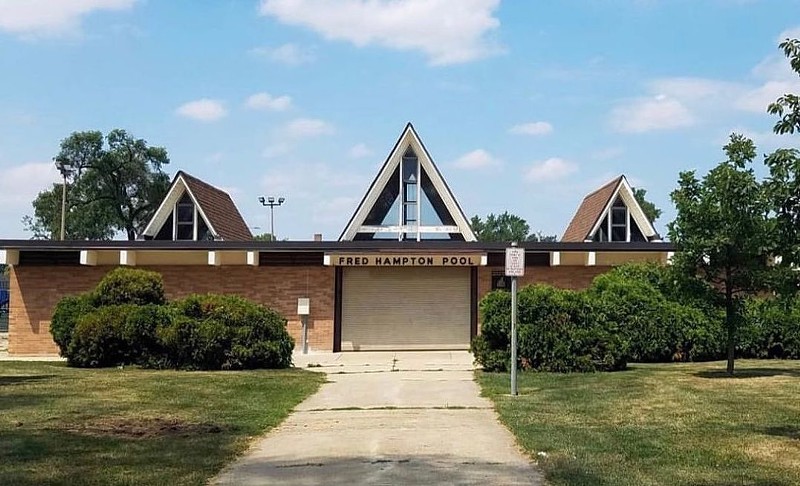
It isn’t the only time pools have played a major role in Cooper’s curation. An Instagram post he made in December features a 1960s TV spot about Miami’s Historic Hampton House. The hotel has been the backdrop for many iconic moments in Black history: the photo of Martin Luther King, Jr. standing shirtless in a swimming pool was taken there. It’s also the spot where Muhammad Ali met with Jim Brown, Sam Cooke and Malcolm X to grab ice cream and celebrate Ali’s shocking victory over Sonny Liston. Due to Jim Crow-era regulations, the Hampton House was the only place the group could convene after dark.
“Until, like, 2007, that hotel looked like a jungle,” Cooper says. “It was dilapidated, the pool had trees bigger than us going through it, and it was not preserved at all. Here’s one of the greatest photos ever seen and then, boom, nobody’s preserving it. It’s a real issue. I think sometimes we don’t think we have anything to preserve because of the worth things are given.”
Drozdz says that even when a structure has outlived its original purpose, it isn’t useless.
“It simply means that we need to get creative about what purpose they can serve next, so that their stories can continue to be written,” she says. “To that end, it's exciting to see something like a church become a brewery or an old school be converted to housing — physical reminders of our history finding a new place in the present.”
All in the Family
On the drive back from Otto’s, Cooper makes sure to point out one building in particular: the West End branch of the Cincinnati Public Library. Though not a particularly large structure, it’s hard to miss its roof, which wraps around in a zig-zagging pattern. Built in the same neighborhood Cooper grew up in, he says that the roof might have been his first exposure to Modernist architecture, piquing his aesthetic curiosity. He featured the library on an Instagram post in the spring, but its jagged shape is a major motif on the Hood Century page. A similar design appears in posts with the lunging silhouette of a Dunkin’ Donuts, the angular exterior of an insurance company’s offices and the facade of a bowling alley turned Starbucks.
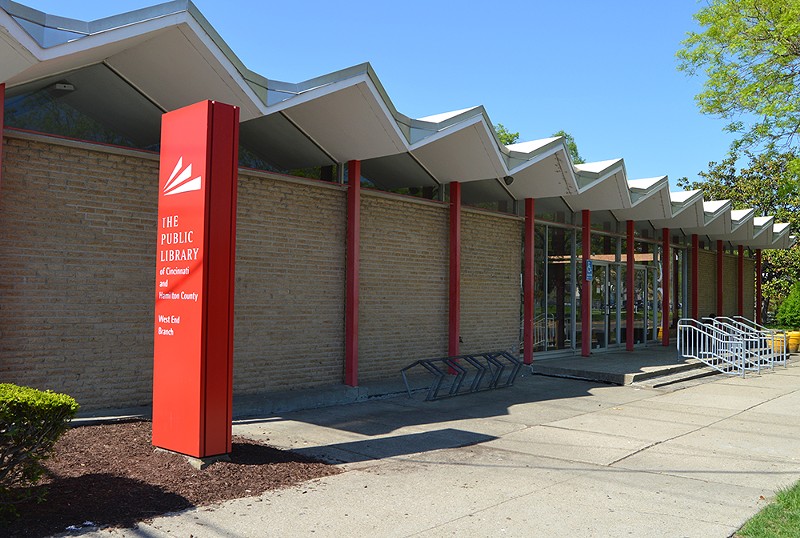
Everything on Hood Century can be traced back to Cooper’s formative childhood memories, and above all, his family. He often features family members in the spaces he snaps. In a post from November, his cousin stands in a warmly lit, open room talking on the phone. Captioned, “lil cuz on his 22nd birthday,” a photo of a skylight sits between another picture of his subject, this time shown lounging in a mostly bare room, save for a painting of flowers.
“Part of what I’ve got going on (in my studio) is that I’m starting to archive my family’s photos,” Cooper says. “I feel like for everybody, old photos are hard to keep up with. With displacement, it’s even harder.”
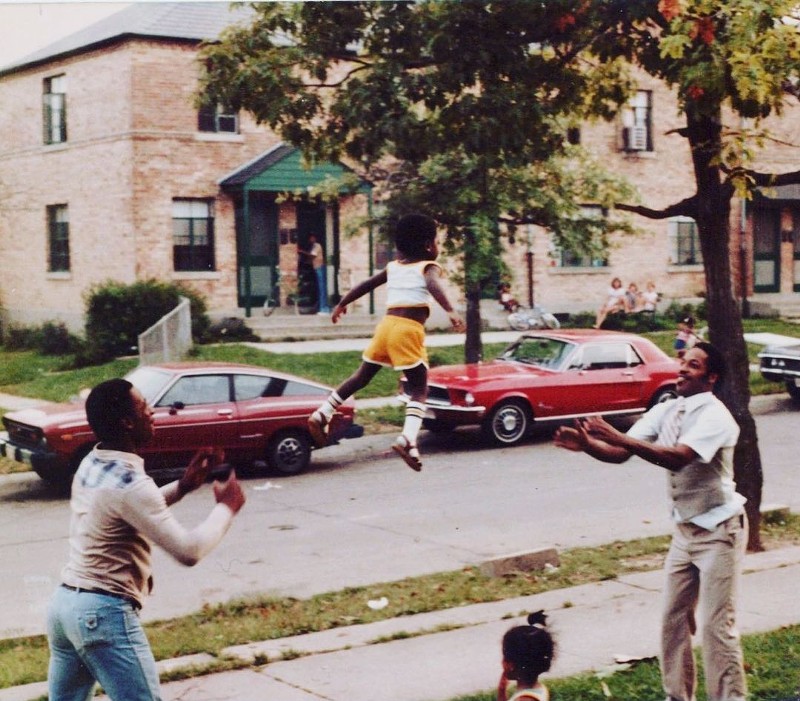
Another post features a throwback photo from his family archives. Dated 1985 at the since-demolished English Woods public housing, it shows Cooper as a young boy being tossed between two family members. He appears to be flying. The next slide is of the neighborhood’s remains: overgrown grass where homes once were.
“This type of displacement that we’ve been around — going to Avondale, College Hill — doesn't allow us to keep our archives,” Cooper says. “To be able to have the thousands of pictures that I’m working through right now, it makes me feel rich.”
Cooper says many members of his large family had yet to learn about the in-process archive. His mom took photos of everyone growing up, which Cooper says makes him feel like they have a hold of their past. He adds that even though his dad, who passed away four years ago, lived through the 2000s, he doesn’t have a lot of videos of him. What Cooper does have, he appreciates.
Cooper says he wants to use Hood Century to show real people connected to the places he photographs, like featuring his cousin in a space instead of a professional model.
Back at Cooper’s studio, he re-watches the final draft of a then-yet-to-be-released Earl Sweatshirt music video for which he’d done set design and location scouting. The rapper paces through the living room of a glass house and watches the sun set from its lush backyard. Cooper’s studio is decorated similarly. Though the space is forged in concrete and white brick, natural light floods the room, which is barely furnished save for his workspace, a yellow armchair and curiosities heaped in piles throughout — including items salvaged from his childhood church.
It’s this archival ephemera that takes up the most space. Though scattered throughout the room on pallets and folding tables, there’s order and symmetry in the layout of these items, from his grandfather’s old store membership cards to the April 1967 issue of a magazine called Hi-Lites, which featured Black-run businesses and events. What might have been the contents of someone’s junk drawer becomes art when carefully arranged for a photo, revealing the character of those who left it behind.
“Archiving, that’s my new shit,” Cooper says. “I’m going to launch a creative strategy studio called That Archival Energy. Think about the (Funk Music Hall of Fame & Exhibition Center) in Dayton, right? Funk is the uncle of Hip Hop — it’s the most sampled music. And Funk comes from here. Not only do a lot of us not know that, but what’s the impact of that?
“Cincinnati swagger is the bed of the identification of who one’s self is in Hip Hop. Hopefully the studio I create helps people with archives get into the mainstream and supported.”
Follow Jerald Cooper’s work and Hood Century on Instagram at @HoodMidCenturyModern.
Stay connected with CityBeat. Subscribe to our newsletters, and follow us on Facebook, Instagram, Twitter, Google News, Apple News and Reddit.
Send CityBeat a news or story tip or submit a calendar event.

